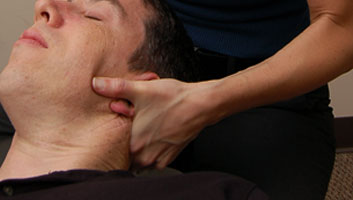
Article written by:
Peter Biskup
Senior Physiotherapist
B.Physio (Hons), M.Physio (Musculoskeletal)
There are some common misconceptions surrounding the practice of neck manipulation, also known as adjustments, or cracking or cavitation.
It is a technique regularly performed by a variety of health practitioners, including physiotherapists, and involves a gentle, small amplitude movement of the neck, but at sufficient velocity to overcome the muscles’ protective response. The movement is associated with an audible “pop”, and is just one method of improving movement and pain in the neck (or sometimes head, shoulder or arm).
“The popping noise is a release of nitrogen.”
Every joint has a small amount of synovial fluid within it, to nourishing the cartilage and help cushion and distribute forces. Spinal joint manipulation causes ‘cavitation’; when the joint surfaces are quickly separated the pressure within the joint drops, causing the carbon dioxide dissolved in the synovial fluid to form a bubble, and then rapidly collapse back, causing the popping noise. It takes approximately twenty to thirty minutes for this gas to fully dissolve back before it will cavitate again.
“The technique is perfectly safe.”
The Vertebral Artery runs through small holes in the sides of the cervical vertebra up into the skull to supply the back part of the brain. Manipulation of the neck has been linked to damage of this artery, and although exceedingly rare, it can lead to serious complications such as stroke or even death. The risk of death or serious vascular accident varies from as much as 1 in 400,000 to as little as 1 in 4,000,000. Physiotherapists are trained to conduct a risk screening assessment (in depth questioning plus physical testing) and discuss treatment alternatives so that you may make a fully informed decision about whether to undergo cervical manipulation. In the right hands, manipulation is very safe, and there have been no documented complications from physiotherapy manipulation.
“It’s better if I don’t know it’s coming. I can relax better that way.”
As mentioned, you should be fully informed and give your verbal consent prior to any cervical manipulative procedure. There are other ways of relaxing the muscles such as heat and massage, without needing a “surprise attack”.
“Cracking the neck puts the vertebra back in place.”
Radiographic imaging studies do not demonstrate measurable change in the position of spinal joints after manipulation. Whilst the cavitation will temporarily improve the freedom of movement of the joints, it is debatable whether subtle joint subluxations are reduced and more normal spinal alignment achieved.
“If I crack the neck too much, I’ll get arthritis.”
There is no proven link between repeated spinal manipulation and osteoarthritis. Unfortunately the main evidence comes from studies of habitual “knuckle crackers”, which show no increased incidence of joint degenerative changes, but do show some loss of grip strength. It is possible that excessive manipulation may similarly weaken the neck.
“My therapist is the only one who can fix my neck when it’s out.”
It is true that many people gain quick relief from manipulation, but your therapist should also be able to show you remedial exercises and teach correct posturing in order to fix the underlying cause of the problem. This way you can maintain your own neck and spinal health. There is good evidence that core stabilisation exercises help resolve back and neck pain, and headaches, and prevent future recurrences. Ask your physio how!
